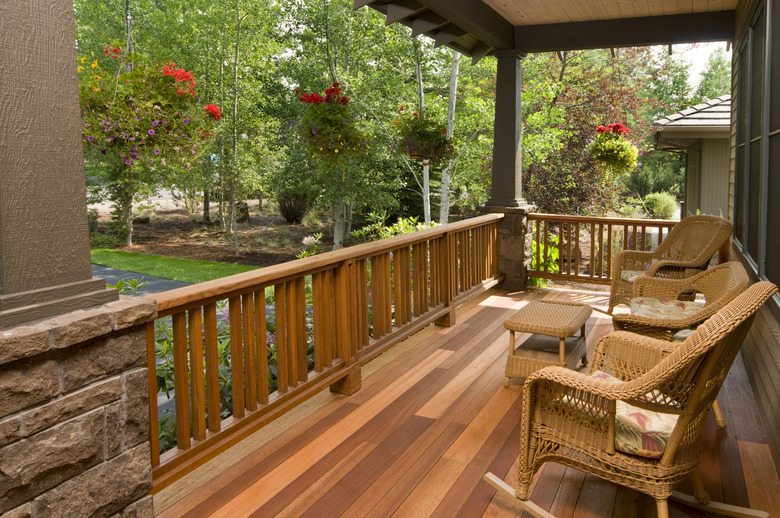How Does Bleach Affect Wood?
We may receive a commission on purchases made from links.
Among the reasons for bleaching wood are to remove unsightly stains, to lighten the natural color and to counteract the darkening effects of age. Bleaching wood is an effective homemade deck cleaner. The three main types of wood bleach all work in essentially the same way — they oxidize the wood fibers and alter color-reflecting molecules. The three main types of wood bleach don't work in exactly the same way, though. One may be better for a certain application than another.
How Wood Bleach Works
How Wood Bleach Works
The molecules that produce color are called chromophores, and bleach changes their composition so that they reflect light differently. The active ingredient in bleach is oxygen, which is actually a highly reactive and corrosive element, despite the benefits it affords creatures that depend on it to survive. It is the element responsible for creating new compounds in the wood fibers that reflect white light more efficiently than colors. In order for bleach on wood to work, the oxygen must be able to penetrate the fibers and cells. It works best if the wood is dry and the grain is open and free of natural oils and resins.
Types of Wood Bleach
Types of Wood Bleach
One of the most powerful wood bleaches is produced by combining sodium hydroxide — lye — with hydrogen peroxide. The combination of these compounds liberates large amounts of free oxygen molecules and quickly oxidizes the surface upon which they combine. Chlorine bleach is another powerful wood bleach — it releases oxygen radicals as well as chlorite radicals — molecules formed of one chlorine and one oxygen atom — which are just as reactive. A third effective wood bleach is oxalic acid. It comes in crystalline form and, when mixed with water, creates an acid that reacts with wood to release oxygen radicals. It is weaker than the other bleaches but useful for removing stains.
Safety Considerations For Wood Bleach
Safety Considerations For Wood Bleach
With the types of bleach used on wood, for the most part, you are safe to use them. When cleaning with the peroxide type of bleach they will oxidize so they are safe to use, but most people do use vinegar to neutralize the wood after bleaching it. Vinegar is non-toxic. When using a chlorine-based bleach, the most dangerous part will be during application because of the fumes. Just make sure to use something to cover your mouth so you aren't inhaling the chlorine.
Which Bleach to Use
Which Bleach to Use
The three main types of wood bleach have specific applications. Because of its strong oxidizing ability, hydrogen peroxide bleach — sometimes called two-part bleach — alters the wood's natural color and is best for whitewashing, aging and fading wood. Chlorine bleach is almost as strong, but it is more likely to preserve the wood's color and is best for removing dyes and problem stains. If you're interested in generally cleaning your wood, or using bleach on hardwood floors to remove dark stains from tannins and iron stains from metal fasteners, and you want to leave the natural color unchanged, use oxalic acid.
Applying Wood Bleach
Applying Wood Bleach
All types of wood bleach must soak into the wood in order to be effective, which means you must sand off the finish before using them. Two-part bleach is effective only immediately after mixing the components; it's best to mix them on the wood. Because chlorine bleach and oxalic acid are not as reactive, you can apply them in a more leisurely way. After you brush or wipe the bleach, the wood should dry, and then you need to neutralize the bleach with clean water. The bleach and water both raise the wood grain, so be prepared to sand the wood after the bleach treatment.
